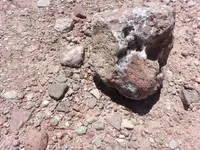SaltwaterServr
Sr. Member
After doing a bit more research, some commercial coal scrubbers don't use any media in the scrubbers at all. They just use the lime-rich mist. Others use media along with airborne mist for the reaction. All in all, its a fairly simple process.
The trick really is getting the lime-rich water to separate from the gypsum salts that precipitate out of solution during the reaction process.
That said, I had to look up how much a power plant burns in coal a year. Turns out a 1000MW station burning coal solely goes through about 200 pounds of coal, per second. The 800MW natural gas plant in my hometown in Texas has a $565,000,000 scrubber system built in. That's just so we know where we're starting from because I've seen the scrubbers and kind of guess the scale, but didn't know how much exhaust they were pushing through them.
On a small scale, I have no idea how much poundage of concentrated ore to expect to roast per day. Like anything else it'll vary by miner, mines within the miner's control, within the pinches and swells of the veins/offshoots, and within the zones of weathering in each of those mines as well.
I can't really see doing more than 500 pounds of concentrated sulfides per day if you're doing gravity or flotation separation to get the heavies out of the gangue. Two double-drum towers would most likely spit out almost nothing but water vapor as long as the system was working correctly.
From what I've come across our gypsum production is a small revenue stream. Here:
https://www.duke-energy.com/environment/land-quality/managing-synthetic-gypsum.asp
While we won't have a lot of it to sell, we'll actually be on the opposite end of the revenue stream compared to having to dispose of waste solutions of acids or strong oxidizers.
The trick really is getting the lime-rich water to separate from the gypsum salts that precipitate out of solution during the reaction process.
That said, I had to look up how much a power plant burns in coal a year. Turns out a 1000MW station burning coal solely goes through about 200 pounds of coal, per second. The 800MW natural gas plant in my hometown in Texas has a $565,000,000 scrubber system built in. That's just so we know where we're starting from because I've seen the scrubbers and kind of guess the scale, but didn't know how much exhaust they were pushing through them.
On a small scale, I have no idea how much poundage of concentrated ore to expect to roast per day. Like anything else it'll vary by miner, mines within the miner's control, within the pinches and swells of the veins/offshoots, and within the zones of weathering in each of those mines as well.
I can't really see doing more than 500 pounds of concentrated sulfides per day if you're doing gravity or flotation separation to get the heavies out of the gangue. Two double-drum towers would most likely spit out almost nothing but water vapor as long as the system was working correctly.
From what I've come across our gypsum production is a small revenue stream. Here:
https://www.duke-energy.com/environment/land-quality/managing-synthetic-gypsum.asp
While we won't have a lot of it to sell, we'll actually be on the opposite end of the revenue stream compared to having to dispose of waste solutions of acids or strong oxidizers.






